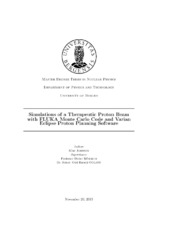| dc.description.abstract | The sharp dose deposition from protons in a medium has some clear advantageous aspects for use in cancer treatment. When charged particles, for instance protons, traverse matter, most of their energy are deposited at the end of their range, causing a sharp peak, the Bragg peak, at a depth determined by the proton range in the medium. This range is a function of the initial proton energy and of the characteristics of the traversed medium. The purpose of this project has been to apply Monte Carlo software to simulate a proton beam resembling a therapeutic beam, and to study the interactions of this beam in phantoms of various design. The simulations were produced with FLUKA Monte Carlo code version 2011 2b. Further the purpose has been to apply Varian Eclipse proton planning (version 11) software to create treatment plans on similar phantoms, in order to study the differences between a time-effective, clinically optimized tool and an accurate, yet time consuming, Monte Carlo simulation tool. A fundamental criteria for a therapeutic beam is that the beam must have the ability to deliver a homogeneous dose to an extended volume. To meet this criteria, the energy of the applied protons must be spread out in order to create a plateau of dose covering the target volume, which is the tumour with some specified margins. This implies that an otherwise monoenergetic beam needs to be energy modulated in order to produce a weighted energy spectrum, resulting in a spread-out Bragg peak (SOBP). In this project, two different approaches were followed in order to obtain a dose deposition with a flat dose plateau at the desired depth. By (1) passively modulating the beam range by inserting material into the simulated beamline, which is the equivalent of the use of a range modifier positioned in the beamline, and by (2) actively modulating the proton energy from the beam source. The resulting dose distributions from these two approaches showed that the dose falloff at the distal part of the target volume was sharper with the active energy modulation approach than when passively using material to modulate the beam energy. The final goal of this project was obtained by the use of a commercial treatment planning system to produce simple treatment plans, and further; to compare the dose profiles to similar treatment plans created with a Monte Carlo simulated beam and geometry. The overall agreement between the two calculation methods were adequate, especially with respect to dose coverage within the defined target volume. However, when introducing different materials such as bone, air and aluminium into the geometry, the differences between the two methods became apparent and it illustrates the tentative limitations of a fast, clinical optimized, dose planning tool compared with a more accurate and detailed, hence tentatively slower, Monte Carlo simulation tool. | en_US |
